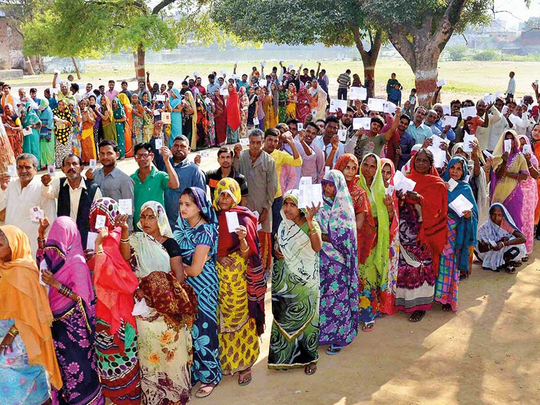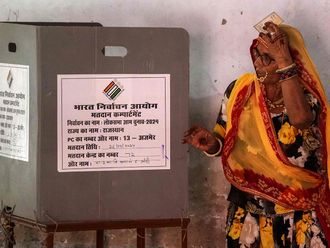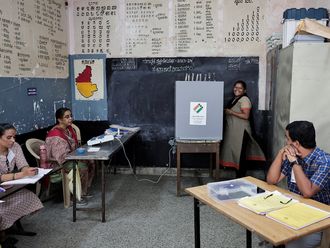
New Delhi: Different trends can have different outcomes depending on regions. While some countries, after experimenting with Electronic Voting Machines (EVMs) for many years, have decided not to continue with the trend and reverted to paper ballots, others are showing increasing interest in using electronic voting technologies.
The issue seems to have come full circle in India where EVMs manufactured in 1989-90 were first used in the November 1998 elections. This was done on an experimental basis in 16 assembly constituencies in the states of Madhya Pradesh (5), Rajasthan (5) and Delhi (6). It was then felt that EVMs were a step in the right direction. The 2004 Lok Sabha elections were conducted using EVMs.
But a few months ago, prominent political parties alleged that EVMs had been tampered with ahead of polls and demanded the reintroduction of the ballot paper voting system.
The call to abandon EVMs was not new. In 2009, when the Congress party was doing well in elections, Bharatiya Janata Party (BJP) stalwart Lal Krishna Advani voiced concerns about the reliability of the machines after his party’s electoral defeat. Many political parties also supported the demand to revert to paper ballots.
However, the Election Commission, citing a study by technical experts that EVMs cannot be hacked, rejected the demand.
Tables turn
The issue made a comeback last year after the results of assembly elections held in five states. By now, the tables had turned. With the BJP in power, this time the call for paper ballots came from the other side of the political spectrum.
The Congress spoke about “apprehensions among political parties and the people” over the misuse of EVMs and urged the EC to “revert to the old practice of using ballot papers as most major democracies have done.” The Aam Aadmi Party and Bahujan Samaj Party supported the move.
The reliability of EVMs came under scrutiny yet again during the Uttar Pradesh civic polls in November last, following reports that several voting machines were recording votes only for the BJP, irrespective of the buttons pressed.
Even though officials replaced the “faulty” machines, blaming a “malfunction”, non-BJP parties alleged the machines had been tampered with.
Slowing down voting
Recently, Samajwadi Party chief Akhilesh Yadav accused officials of using defective machines to slow down voting in polling booths in Uttar Pradesh’s Gorakhpur and Phulpur constituencies, where his party was expected to do well.
Amidst the allegations, the BJP said it was open to discussions on reverting to paper ballots, if there was consensus among other parties on the matter.
BJP general secretary Ram Madhav stated, “The decision to shift from paper ballots to EVMs was taken because of a larger consensus. Today, if every party thinks we should return to paper ballots again, we can consider.”
However, dispelling doubts about security issues surrounding EVMs, former Chief Election Commissioner of India Nasim Zaidi reiterated that the machines are tamper-proof.
Zaidi told Gulf News, “Many political parties at different times have levelled allegations of hacking and tampering of software and hardware of EVMs. Even technical malfunctioning of machines, before and during polls or counting has been cited as evidence of tampering by opponents of EVMs.
“The allegations [of tampering] have been examined in petitions by various courts, including the Supreme Court, only to be rejected by them. The EC, in 2009 and 2017, had asked political parties, activists and individuals to demonstrate tampering of EVMs before the commission. But, on both occasions, they either backed out or made feeble and unsuccessful attempts. Last year, only the Nationalist Congress Party and Communist Party of India-Marxist came forward — only to have better understanding of machines.”
Voter-verifiable paper audit trail
The EC has consistently defended the voting machines. In 2010, with the help of independent technical experts, it considered introducing the voter-verifiable paper audit trail (VVPAT) to enhance transparency.
Under this system, a paper slip is generated bearing the name and symbol of the candidate for whom the elector has voted, confirming the vote has gone to the candidate selected by the voter. VVPATs were first used in the Nagaland by-elections in 2013 and recently in the 2017 assembly elections in Gujarat and Himachal Pradesh.
“The already established credibility of electoral process through EVMs has now been further enhanced 100 per cent by the use of VVPAT,” Zaidi stressed.
“So, unless parliamentarians legislate otherwise, there seems no possibility for India to go back to [the] ballot paper system,” he added.
In June 2014, the EC advocated using the VVPAT system at every polling station for the 2019 Lok Sabha polls.
Not tamper-proof
India is home to the world’s second-largest population, and by default, becomes the largest to vote in a democratic process using EVMs. The machines may have saved the country by reducing the amount of manpower and paper, but people with technical know-how say that though reverting to paper ballots would be a retrograde step, it would be inaccurate to claim that the machines are completely tamperproof.
Scientist and social activist Gautam Raza claimed, “Tampering has been mastered by many agencies, institutions and individuals and an EVM is not a novel machine which cannot be hacked. There is no machine in the world that is impenetrable. An EVM can be manipulated by a remote device.”
On the electoral body’s contention that incidents of booth capturing have been rare since the advent of EVMs, Raza, an Indian Institute of Technology (IIT) graduate from Delhi, added, “The reason is not EVMs. While the marginalised, and people from lower strata of society have become conscious and aware of the importance of their vote, others realise that because of mobile phones, incidents like booth capturing cannot remain hidden. But then tampering with a machine is akin to booth capturing. This kind of booth capturing does not require muscle power. It’s invisible and, therefore, more dangerous.”
“The solution to EVMs is VVPAT as a stand-alone device to cast votes. It should not be connected with an EVM. This will not only restore public confidence, but also retain the virtue of democracy,” he suggested.
How an EVM functions?
■ An electronic voting machine (EVM) comprises two units — a ballot unit (BU) containing the names of candidates (arranged in alphabetical order) and symbols against each button and a control unit (CU) containing the memory and display component.
■ A voter-verifiable paper audit trail (VVPAT) is connected with the BU and the CU.
■ The BU, CU and VVPAT are interconnected by an insulated cable visible to voters and polling agents all the time.
■ The CU is with the polling officer, while the BU and VVPAT are placed inside the voting compartment, enclosed on three sides to maintain secrecy of voting.
■ Each time a voter enters, the polling officer presses the BU button. As the green light glows, it enables the voter to cast the vote of his choice by pressing the button on the BU against the candidate’s name and symbol.
■ Instantly, the serial number, name and symbol of the candidate appears on the window of the VVPAT, remaining for about seven seconds to enable the voter to confirm that his vote has indeed gone to the intended candidate.
■ After seven seconds, a loud beep is emanates from the CU, indicating the vote is cast.
■ After voting, the close button is pressed and the machine disabled so it cannot accept any new data.
■ On the day of counting of votes, the counting official — in full view of the counting agents of candidates — presses counting button on the CU that displays the number of votes polled against each candidate.
Advantages of EVMs
■ The printing of millions of ballot papers is dispensed with, which is a huge saving by way of the cost of paper, printing, transportation, storage and distribution.
■ There are no invalid votes. (The importance can be gauged keeping in mind that in every general election, a huge number of votes are marked invalid).
■ An EVM permits only 240 votes per hour. Hence, the stuffing of votes (as in ballot boxes) is not possible.
■ EVMs empower people from weaker sections of society who were victims of political or electoral violence.
■ An EVM run on an ordinary 6-volt alkaline battery, therefore, it can be used even in remote areas not connected to the national power grid.
The paper ballot and its disadvantages
■ The cumbersome process requires a voter to first unfold the ballot paper, mark his preference, fold it again, go to the place where the ballot box is kept and drop it in the box.
■ Malpractices include prevention of people from participating in election process.
■ There have been cases of ballot-box stuffing and ink thrown in ballot boxes, making it impossible to figure out which candidate’s name has been picked.
■ Marked, unmarked, wrongly marked or multi-marked ballot papers are subjected to the decision of the returning officer.
■ Battalions of security personnel have to be transported to ensure the safety of thousands of ballot boxes and to prevent booth capture.
■ Thousands of government employees (who count votes) are locked up in rooms for days, while they count votes.
The counting of votes for one assembly constituency
EVMs: 2-3 hours
Ballot paper: 30-40 hours
Figures
■ In the 2014 elections, 1.4 million EVMs were used at 930,000 polling stations spread across the country. Electorate size stood at 817 million.
■ As per January 2018 data, the electorate size is approximately 877 million.












